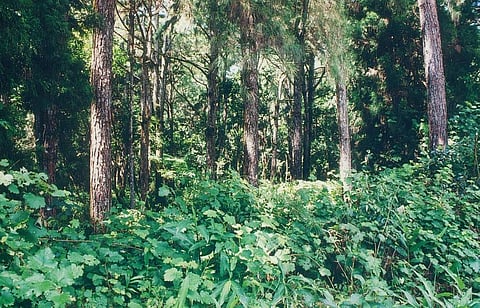

A new ecological study by scientists of city-based Centre for Wildlife Studies (CWS) and collaborators has generated methods on conservation of tropical forest ungulates.
The scientific monograph titled 'Spatial Dynamics and Ecology of Large Ungulate Populations in Tropical Forests of India' has been published by 'Springer Nature', a research publisher. The publication is based on field work and analyses conducted on population ecology of five species of threatened ungulates: Gaur, Sambar, Chital, Muntjac and Wild Pig in the Nagarahole-Bandipur protected landscape, a CWS statement said on Monday.
The study involved the conduct of line transect surveys on foot, designed and implemented advanced distance sampling methods, CWS said. The data generated were analysed using spatially explicit hierarchical distance sampling models, one of the first studies in the world employing these advanced methods. The study rigorously estimated population densities of these five ungulates at both local and landscape scales, and explored causal factors underlying the variations in their densities in terms of different ecological and management factors, according to the statement.
The results showed that population densities of focal species locally varied between 0.2 and 5.1/ sq km for gaur, 0.5 and 8.1/ sq km for sambar, 0.9 and 39.8/ sq km for chital, 0.1 and 0.7 / sq km for muntjac and, 0.1 and 1.1/ sq km for wild pig, in response to varying environmental factors.
The analytic methodology of 'Bayesian Hierarchical' modeling used by the authors, generated more rigorous and nuanced results useful for conservation, without involving any additional investment of resources compared to standard line transect sampling, it was stated. CWS scientist Samba Kumar said "Our results have both scientific and management implications. " These are the first population ecology data and results gathered at such fine-grained scales on these vulnerable species which are under threat across their range in Asia, he said.
The study also highlights the importance of strict anti-hunting measures and regulation of human impacts on habitats, which it said are far more important to recover these species than many of the expensive commonly employed habitat management practices. "Our study also provides a scientifically robust decision-making framework to prioritise management actions to accomplish conservation goals," Samba Kumar added.
CWS Director K Ullas Karanth said "The approaches we developed and the results we generated have wide application for surveying large ungulate populations all over the world". In view of the fact that almost all the putative line transect surveys now being conducted across Asia, including those in India, lack rigour and generate unreliable results, there is ample scope for adopting our methods in the future, according to him. "Because tropical forest ungulates are under serious threat, I hope such adoption will be prioritised by the government," he added.
James Nichols (University of Florida, USA) said "With a few notable exceptions, our knowledge of the population ecology of large, mobile animals is very limited, primarily because of the difficulty of studying such animals at relevant spatial scales. " The study provides strong inferences about the spatial ecology and conservation of the focal ungulates and provides a model for the large-scale study of mobile animal populations, Nichols said.
